
Industry News
News
Reducing wildfire risk increases community safety in Kaslo, B.C.
August 30, 2022 By Forest Enhancement Society of BC
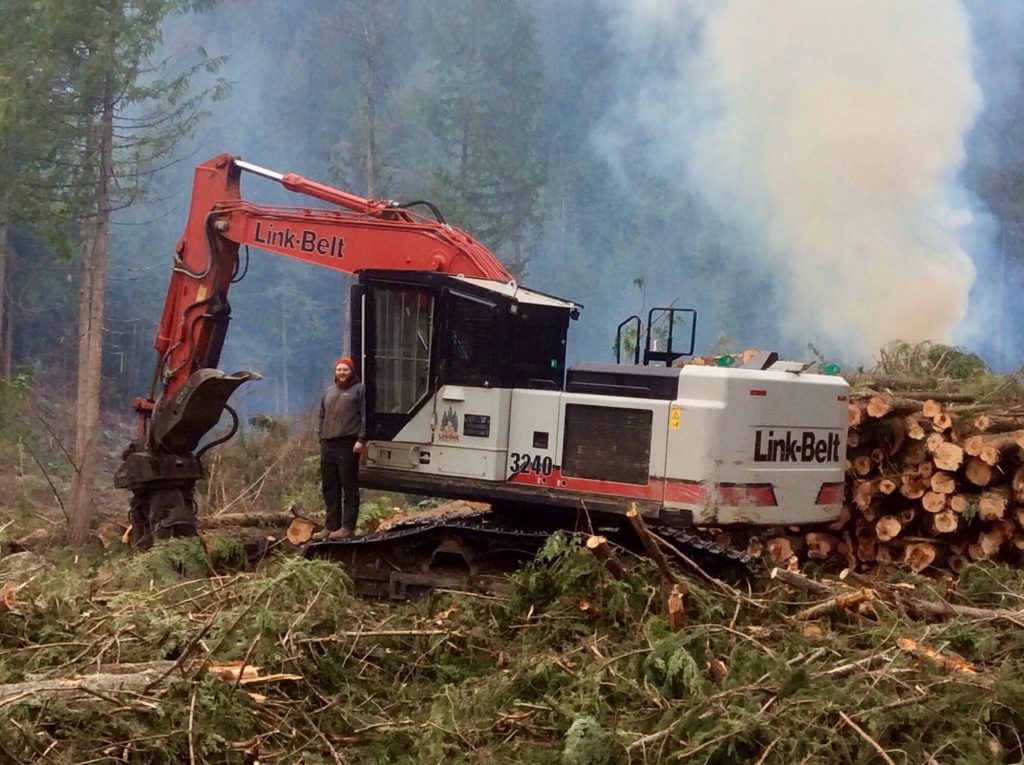 Connor Robertson, from Timber Ridge Contracting pictured piling debris. Photo: Kaslo and District Community Forest.
Connor Robertson, from Timber Ridge Contracting pictured piling debris. Photo: Kaslo and District Community Forest. When the Kaslo & District Community Forest Society (KDCFS) first applied to obtain funding from the Forest Enhancement Society of BC (FESBC), they knew of the long-term benefits their projects would bring, but little did they imagine the many additional and immediate benefits the funding would allow for.
FESBC funding of almost $185,000 went toward three projects; a Landscape Level Wildfire Protection Plan, Schroeder Creek Forest fuel reduction and stand conversion from hemlock to more fire and climate change resistant tree species of douglas fir and larch, and the Buchanan East Access hand treatment implementation to reduce a build-up of forest fibre in the area.
Through the Landscape Level Wildfire Protection Plan (LLWP), new roads to provide access for firefighters in the event of an emergency and fuel reduction projects were identified, which helped guide forest operations for almost three years. Through the implementation projects, KDCFS helped reduce the risk of wildfire not only for the community of Kaslo but for the property of a private landowner and the community of Schroeder Creek, all by reducing fuel loading in the forests close to them. Recreation values were also further increased in the Buchanan project, with a happy private landowner benefiting from the reduced fuel loading near their residence and driveway in the Schroeder project.
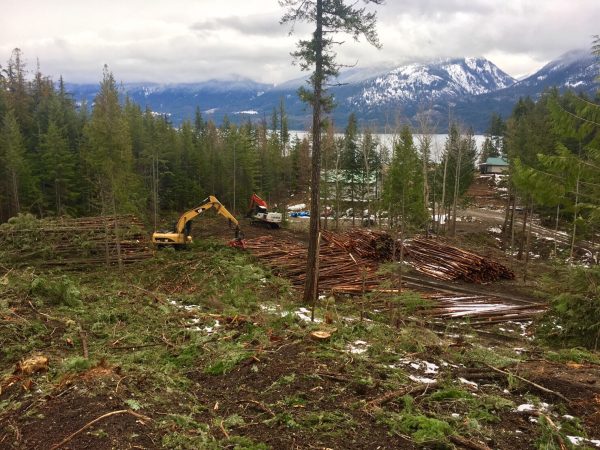
Schroeder project with the private residence in the background. Photo: Sabrina Mutterer
Gord Pratt, RPF, FESBC senior manager, said, “FESBC is very pleased we were able to assist the Kaslo & District Community Forest with their wildfire risk planning and treatments. This work contributed to reducing the wildfire risk to the village of Kaslo and surrounding areas, plus providing local employment, and enhancing some of the important recreation features in the community forest.”
Of the three projects that KDCFS undertook with FESBC funding, the Schroeder Creek fuel reduction/stand conversion project, which was located next to the private land where the landowner’s house had almost burned down due to wildfire in 2012, made a substantial impact on the community, explained the manager of the community forest, Jeff Reyden, RPF.
“Schroeder Creek, which is 15 kilometres north of Kaslo, is where the private landowners almost lost their house because of a wildfire. Their driveway is one way in, one way out. Most of the area had over-dense, stagnant regen growth and a lot of forest fuel on the ground due to old high-grade logging,” explained Reyden.
In the area, the forest had been logged in the 1970s and had regrown primarily with thick, immature hemlock. High winds in recent years had blown down many trees making the forest almost impassable on foot. In some areas, dead trees were piled nearly five feet tall. Doug Drain and Helen Hird, the landowners, watched as the wildfire spread through the cedar stand on the steep slope of their property. While the wildfire was stopped before reaching the home through the efforts of the Kaslo Fire Department and BC Wildfire Services (BCWS), a delay in deployment or a shift in the direction of the wind could have had more devastating impacts. Since the wildfire in 2012, the site had become even more dangerous and susceptible to a potential wildfire. Post-fire, the area was evaluated and designated as Extreme Fire Risk by BC Wildfire Service (BCWS). It was after this that Sabrina Mutterer and Jeff Reyden of the KDCFS applied for and received funding for fire mitigation in the area, including the Schroeder Creek community, for which Drain and Hird are thankful.
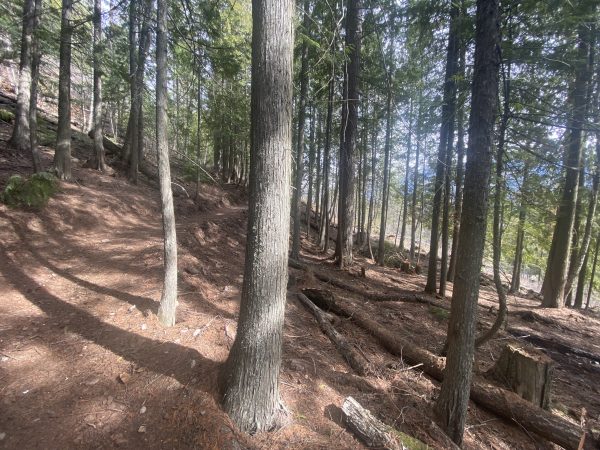
Schroeder Creek post-treatment. Photo: Kaslo and District Community Forest
“Fire mitigation work has had a major effect on our lives, especially our peace of mind,” explained Drain. “Over the years we have lived here, we have feared what might happen with a tossed cigarette butt along the highway below us every summer, especially on long weekends. Watching the fire mitigation work, it was apparent that had a fire started, we had absolutely no hope of escaping alive. Fire mitigation does not mean fireproof, but at least now, with preparation, we have a fighting chance or at least a safe means of orderly retreat.”
The community forest divided the area into two treatment units (TU). TU1 was more mature timber with funding for postharvest cleanup and pile/burn. TU2 was overly dense, skinny hemlock regen which was too small to fit on a logging truck, so the contractor skidded them (a process of pulling cut trees out of a forest using heavy machinery) to a burn pile.
“The FESBC funding allowed us to skid these trees and burn them concurrently with harvesting. If we had to do the harvesting first while piling the debris to be burned by another contractor, the piles would have been enormous, a potential fire hazard, and difficult to work around, costing the community forest and the grant funder significantly more time and money,” said Reyden.
The area will now be planted with fire-resistant species, with reduced stocking along the driveway, to provide a more firesafe route back to the highway. Drain noted that the project has also enhanced wildlife habitat.
“Opening up the forest has made a huge difference to the wildlife that lives here. Spring now brings a huge crop of sweet clover just about when the bears wake up. This year we had seven bears and two cubs contentedly grazing on clover for a few weeks. We have deer and elk that were never here before as there was nothing to eat,” adding that most creatures seem to be thriving post-treatment. The work also brought employment opportunities to local contractors.
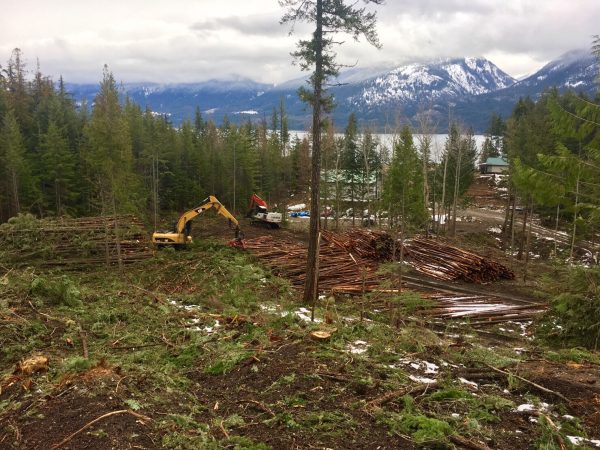
Schroeder project with the private residence in the background. Photo: Sabrina Mutterer
Shane McKinnon, owner-operator of Timber Ridge Contracting Ltd., pointed out that the work KDCFS was doing meant a steady stream of work for his company that allowed him to add two full-time employees, as well as hire local logging truck operators. He believes the work done by KDCFS was important for the community. “Right now, we have options and time to plan our harvesting areas and access, and we need to take advantage of this because when there’s a fire close to our community, the planning has to happen fast. Creating access around our community is important for response times, and the work KDCFS is doing is vital,” said McKinnon.
The need for creating access was highlighted recently when a wildfire broke out near Kaslo just last month. Reyden, who got an opportunity to fly with the BCWS to assess the fire situation, noted that it was a little unnerving to see how fast and far the fire spread in one evening.
“When we see fire close to our community, people want to see bombers and choppers, but due to the terrain and the way the fire was burning these actions wouldn’t have been as effective as hoped. It’s a bit of a wake-up call in that fire can affect any community and can spread rapidly under the right conditions, and the best way to fight forest fires is by having access to enable crews to action the fire,” Reyden noted.
Minister of Forests, Katrine Conroy, understands the importance of this proactive work and is pleased to see the efforts put forth by the KDCFS in collaboration with so many community members.
“We have a shared responsibility to help build communities that are resilient to the impact of wildfire and climate change,” said Conroy. “That’s why we invested an additional $25 million through FESBC this year so that local governments, Indigenous communities, and rural communities can deliver projects that lower the risk of wildfires and the damage they can cause. The proactive work they are undertaking is alongside historic investments in Budget 2022 to transform the BC Wildfire Service into a year-round service. Our shared efforts will ensure a safer and more resilient future for all British Columbians.”
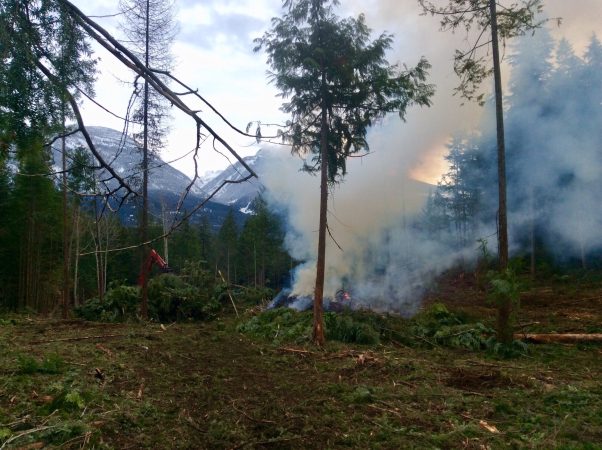
Post-harvest clean-up and pile burning. Photo: Kaslo and District Community Forest
“Kaslo residents have lived with fire for over a hundred years, with old pictures of Kaslo from the turn of the century showing barren, treeless hillsides as they had all been burned,” added Reyden. “Having access to fight a forest fire is crucial, as well as a coordinated effort between stakeholders to effectively fight the fire. The funding from FESBC has been essential in getting started on these efforts.”
Print this page